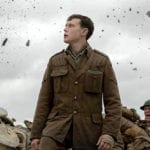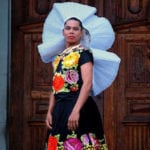 Our World
Our World  Our World
Our World  Movies and TV
Movies and TV The 10 Coolest Stars to Set Sail on The Love Boat
 History
History 10 Things You Didn’t Know About the American National Anthem
 Technology
Technology Top 10 Everyday Tech Buzzwords That Hide a Darker Past
 Humans
Humans 10 Everyday Human Behaviors That Are Actually Survival Instincts
 Animals
Animals 10 Animals That Humiliated and Harmed Historical Leaders
 History
History 10 Most Influential Protests in Modern History
 Creepy
Creepy 10 More Representations of Death from Myth, Legend, and Folktale
 Technology
Technology 10 Scientific Breakthroughs of 2025 That’ll Change Everything
 Our World
Our World 10 Ways Icelandic Culture Makes Other Countries Look Boring
 Our World
Our World 10 Ways Your Christmas Tree Is More Lit Than You Think
 Movies and TV
Movies and TV The 10 Coolest Stars to Set Sail on The Love Boat
 History
History 10 Things You Didn’t Know About the American National Anthem
Who's Behind Listverse?

Jamie Frater
Head Editor
Jamie founded Listverse due to an insatiable desire to share fascinating, obscure, and bizarre facts. He has been a guest speaker on numerous national radio and television stations and is a five time published author.
More About Us Technology
Technology Top 10 Everyday Tech Buzzwords That Hide a Darker Past
 Humans
Humans 10 Everyday Human Behaviors That Are Actually Survival Instincts
 Animals
Animals 10 Animals That Humiliated and Harmed Historical Leaders
 History
History 10 Most Influential Protests in Modern History
 Creepy
Creepy 10 More Representations of Death from Myth, Legend, and Folktale
 Technology
Technology 10 Scientific Breakthroughs of 2025 That’ll Change Everything
 Our World
Our World 10 Ways Icelandic Culture Makes Other Countries Look Boring
10 Common Things That Are Far More Dangerous Than The Things You Actually Fear
The world can be a frightening place. Images of violence, natural disasters, accidents, and other such dangers permeate our media, sowing fear in many. While these threats should certainly be respected, other far more mundane things in our lives are statistically much more likely to kill us.
Note: This list primarily shows statistics for the United States. This is not out of deliberate ignorance of the rest of the world but simply due to the ready availability of US-based statistics.
10More People Die Falling Out Of Bed Than From Roller Coasters

Some people love roller coasters; some people are terrified of them. The high speeds and great heights provide a relatively safe thrill for amusement park goers. However, accidents do happen, and roller coasters kill an average of four people in the US each year.
One-quarter of roller coaster deaths are occupational fatalities involving workers. Half are caused by a rider’s medical condition being exacerbated by the ride; these can be prevented by increased signage warning sufferers of certain conditions against boarding. Only the final quarter are caused by some sort of trauma to a park visitor, such as falling out of the roller coaster.
Rest assured: You probably won’t be killed the next time you ride a roller coaster. You’re much more likely to die from falling out of your own bed. Every year in the US, 450 people die this way. Ironically, bed rails sometimes make things worse. Hospitals have found that stubborn patients try to climb over them and fall farther than they would have otherwise.
9Cows Are More Likely To Kill You Than Bears

Fatal black bear attacks on humans have been rising in North America since the 1960s. Over the past 110 years, 63 people have been killed by black bears, mostly in Alaska and Canada. This amounts to fewer than one person per year. However, since 86 percent of these fatalities occurred after 1960, the current average is closer to two people per year.
Increased human encroachment into black bear habitats is cited as a probable cause. Most fatal attacks have been perpetrated by lone male bears sampling humans as a new food source. Surprisingly, mother bears defending their cubs or bears that have become familiar with humans are responsible for few fatalities.
While injurious encounters with black bears may continue to rise with human expansion, they have a long way to go before they kill more people than cattle, which kill an average of 22 people per year in the United States alone. Most fatal attacks on humans by cattle are deliberate, either by territorial bulls trampling and goring farmers or mothers protecting their calves. Other times, people are simply accidentally crushed.
8A Rip Current Will Get You Before A Shark Does

Going to the beach is a common and beloved summer pastime for people across the world. Such outings are not without danger, of course. You could get sunburned, stung by a jellyfish, or bitten by a shark.
Most unprovoked shark attacks on humans are cases of mistaken identity, where the shark takes one bite and then swims away upon tasting a distinctive lack of seal or fish. Those single bites can still cause serious injury or death. Even these mistakes are comparatively rare; most sharks that attack have been provoked by a human in some way.
All the same, if you’re in the water and feel yourself pulled away from safety, a rip current is much more likely to be responsible than a shark. Rip currents are more powerful than you may realize. They can pull you away from shore faster than an Olympic swimmer can swim. Trying to directly swim against a rip current, a common reaction, will only lead to fatigue and drowning.
It is estimated that over 100 people drown each year in the US due to rip currents. Conversely, despite some swimmers going to such extremes as taunting sharks, someone dies in the US from a shark attack only once every two years. Worldwide, only five die each year.
7High School Sports Kill More US Citizens Than Terrorists Do

Terrorism has been a defining fear in 21st-century US culture since the horrifying 9/11 attacks in 2001. From Al-Qaeda to ISIS, the news has frequently been filled with frightening terroristic imagery, causing many citizens to fear for themselves and their children.
In truth, US children are far more likely to end up dying on their high school playing field than at the hands of a terrorist. Roughly 50 young athletes die each year in the United States due to sports-related injuries. Rural areas are the worst-affected. Common causes of death include overheating (more on that later), brain injuries, and sudden cardiac arrest. It certainly doesn’t help that two-thirds of athletes show up to practice significantly dehydrated. Nor does it help that 16 percent of football players who are knocked unconscious from a hit will play more that same day; those who suffer further injury as a result have a 50/50 chance of dying. Sudden cardiac arrest kills 90 percent of the young athletes that it strikes.
Terrorism, on the other hand, has taken roughly 12 private US citizens per year, with 2001 an obvious anomaly. For example, terrorism killed nine in 2009, 10 in 2010, 17 in 2011, 10 in 2012, and 16 in 2013. The overwhelming majority of these deaths involved travel to Afghanistan. Not one death occurred within US borders.
6Disney World Kills More Than Florida’s Alligators

From 2005–2014, eight visitors to Disney World in Orlando, Florida were killed. Heart attacks (sometimes worsened by a lack of readily available defibrillators) and traumatic injuries are common causes. Five workers have also been killed in that time span, including three during a particularly bad season in 2009, by trauma or electrocution.
Some might consider Florida’s alligators to be more frightening than Mickey Mouse. The prospect of being bitten or dragged under and drowned by one of these ancient reptiles is certainly grim. While most alligators only attack if provoked, unprovoked predation does occur. Victims are often completely unaware of the alligator until it attacks. Still, you’re more likely to win the lottery in Florida than be killed by a hungry alligator. From 2005 to present, only six people have died in unprovoked alligator attacks. None have died since 2007.
5Summer’s Heat Will Kill You Before Lightning

Not only does it simply get hot in summer, but it’s also the time of year where one might have the greatest fear of encountering temperatures hotter than the surface of the Sun. Lightning can reach temperatures of 30,000 degrees Celsius (50,000 °F), causing severe burns, as well as killing an average of 51 people each year in the United States. Contrary to popular belief, most lightning strike victims are not struck directly but instead succumb to simply being near another object that is struck. This is why it always best to move indoors during a thunderstorm, as lying flat in a field will do nothing to save you from indirect strikes.
While you’re running inside, you might want to check your air conditioner, as you’re over 10 times more likely to die from excessive heat exposure, which generally kills 618 people each year in the US. Dying by heat is a surprisingly nasty way to go. As your temperature rises, in addition to sweating, your body tries to cool down by pumping more blood closer to the skin to radiate heat. If you can’t cool down, more and more blood is pumped away from your internal organs.
The lack of oxygen from blood strains the organs, while the continuing heat buildup causes an inflammatory response across the whole body, making it even harder to cool down. Once your temperature reaches 40 degrees Celsius (104 °F), your brain will get less blood due to increased intracranial pressure, and damaged tissue in the blood may cause your kidneys to fail. If your body makes it to 49 degrees Celsius (120 °F), and you’re not already dead, your cells will suffer direct heat damage.
4Worry More About Wind Chill Than Tornadoes

Hypothermia is an arguably sneakier killer than heat. Mild hypothermia may only manifest as the usual attributes of “being cold,” such as shivering, fingers feeling numb, and so on. If shivering isn’t enough to warm the body back up, it will do the opposite of the heat response described above and divert blood away from the extremities and into the internal organs.
Violent shivering will begin once the body’s temperature drops to 35 degrees Celsius (95 °F) but cease below 32 degrees Celsius (90 °F). At this point, the sufferer will be unable to think clearly and may even irrationally remove clothing.
Unconsciousness comes at 30 degrees Celsius (86 °F). At this point, a hypothermia victim may appear dead, as their body has slowed its metabolism to reduce oxygen requirements. Heart rate and respiration are quite slow. The heart finally will stop at 20 degrees Celsius (65 °F), though arrhythmias may cause death as soon as 28 degrees Celsius (82 °F).
Exposure to excessive cold kills roughly 1,300 people per year in the US. It would have to be a truly terrible and record-shattering weather year for tornadoes to match that. They kill 75 US residents each year on average. That chill you may feel in your fingers as you clear snow off your car this winter is a much more pressing danger than those thunderheads you may see in the distance this summer.
3Food Poisons More People Than Carbon Monoxide

Carbon monoxide (CO) is an even stealthier winter killer than hypothermia. You can’t see it, taste it, or smell it, and it won’t even make you sneeze or cough. Cars produce it every day, and your furnace might make the next cold winter night your last. After being inhaled, CO kills when it enters the bloodstream. It bonds to the hemoglobin in blood, which normally bonds with oxygen and carries it throughout the body. Carbon monoxide makes blood useless. Every year, 430 people die in the US of CO poisoning.
Don’t run away from your gas stove just yet; you need it to make sure your food is properly cooked. Foodborne diseases kill 3,000 US residents per year. A plurality of food poisoning cases are caused by poultry, although fruits, nuts, and leafy greens cause many cases as well. Several deaths might be prevented by simple measures such as proper hand-washing and cooking food to the correct temperature.
2Your Doctor’s Bad Handwriting Will Kill You Long Before Ebola

Ebola is a terrifying disease. The pathogen attacks nearly every organ and system in the human body, sparing only bones and muscles. Connective tissue such as collagen is effectively dissolved. Without that foundation, the skin floats over liquefied tissue, and the sufferer will bleed spontaneously from various orifices. This only gets worse once bloody vomiting and diarrhea commence. Blood loss ultimately kills an Ebola victim.
Fear of the disease led airports in the US and other countries to screen incoming passengers from West Africa. Despite this, health care workers in the US contracted Ebola, sparking fears of an outbreak. Four people were diagnosed with Ebola in 2014; one died, while the others recovered and were released from treatment. The one person who died caught the virus in Liberia.
Patients at the Texas Presbyterian Hospital in Dallas, Texas, the site of three of the four Ebola cases, faced a much greater risk even during the stays of the Ebola patients: their doctors’ bad handwriting. A doctor’s frequently illegible notes or prescriptions may seem like joke fodder, but it leads to an average of 7,000 deaths every year in the US. Consider that 3.2 billion prescriptions are written annually. Bad writing can easily lead to the wrong dosage, and an unclear abbreviation might lead to the wrong medication being dispensed.
1Binge Drinking Kills More People Than All Other Drugs Combined

Sending a child off to college can certainly be stressful for concerned parents. They’ve kept their kids away from cows, bundled them up in the winter, cooked food just right, and made their pediatricians print every prescription. Now the time has come for the kid to leave the nest, get a degree, and ultimately land a good job. Of course, there’s always the frightening possibility that he or she will get hooked on drugs while they’re away. A bigger concern might be how much the kid has to drink.
Roughly 80,000 Americans die each year from binge drinking, defined as five or more alcoholic drinks in a short period of time for men or four or more for women. Most of these deaths may not be from direct alcohol poisoning, but car crashes and drunken violence can be just as deadly.
Only about half as many people die from drug overdoses in the US each year: for example, 41,000 in 2011 and 44,000 in 2013. These figures include overdoses on legal prescription drugs; illegal drugs constitute less than half of overdose deaths. In other words, parents should worry more about frat parties than a marijuana-smoking college roommate.
Anthony’s warnings to the Department of Homeland Security about the dangers posed by high school sports keep getting ignored for some reason.








